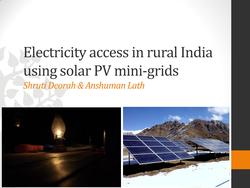Prospects for Electricity Access in Rural India using Solar Photo-Voltaic based Mini-Grid Systems
Prospects for Electricity Access in Rural India using Solar Photo-Voltaic based Mini-Grid Systems
Presenters: Anshuman Lath (Gram Oorja Solutions Private Limited) and Shruti Mahajan Deorah (Goldmann School of Public Policy, UC Berkeley)
Overview
| Solar photovoltaic (PV) based mini-grid systems have the potential to be an environmentally friendly and sustainable long term solution for electricity access in India. However, the high upfront costs of these mini-grids present policy makers, entrepreneurs and consumers alike with difficulties in financing them. Other challenges to their implementation stem from socio-economic issues and from the lack of adequate support from government agencies. We assess the potential for deploying solar PV based mini-grids to provide on demand electricity access, beyond just lighting. We describe one very high-quality installation in detail, in operation for 20 months now, that exemplifies several of the challenges involved in providing end-to-end solutions in rural India, as well as some solutions. We review the policy measures of the Indian government in the context of scaling out such innovative solutions, and argue that government must work together with entrepreneurs to create an Energy revolution akin to the Green revolution in India in the 1970s[1]. |
Main Topics Discussed
• Observer research foundation in Mumbai –worked in the passed –Shruti
• Ladakh very remote area, northernmost part
• Largest amount of people still lacking access to electricity
• Very blessed with solar energy- the entire country
• The best practices are applicable to any energy
• Biggest challenge comes from policy and entrepreneurship- issues with tendering etc
• There is a clear mandate and will by Indian government to use sustainable electricity projects
• ;arge parts of india in markets run on diesel. They do not focus on those people believe that grd is going to reach at some point
• 39 households- small village. Just lighting solutions cannot keep mini grids sustainable. Strong community involvement: Darewadi
• Were fine without electricity, primary agriculture activities
• 30-35 year want the technology to stay to cover costs
• Mini grid transferring everything to the community
• Households use kerosene for lighting and wanted to access entertainment like in the city. Lighting means that you can always go back to kerosene therefore wanted to focus NOT only on lighting. Pumps are VERY important now (for water). Photocopy machine can run on energy and this is a discovered use of electricity
• In the very bad monsoon months there is a drop in electricity
• Have a metered connection of about 20 rupees of kw/h. but this should be enough to cover costs of batteries. Monthly bill comes every month. For the next 4-5 years it can function. Makes system sustainable
• As pumps kicked in, now the use of energy has increased and therefore can help in battery change and even generate revenue
• Quality of installation is up to utility specification and can be long term
• People in the village can connect to a wider system not just a tiny system
• Complete transfer of ownership- higher intensity of keeping care of system
• Leakage in the system if don’t sustain: battery, tariff stricture, community interaction, ownership transfer or design aspirations (not only focus on lighting)
• A lot of migration in urban center for entertainment
• 25-year period can sustain the project
• Developmental angle came into village just because of access to energy
• Average daily sunshine 3.5-4 kw of usable power per kw installed
• At least maintain micro grids for 25 years it’s a success because others have failed
• US$7 billion- the cost used to extend the grid in the country- by government
• Person trained to sustain system on day-to-day basis
• Pumping load- do not need energy backup of can push usage to the time
• Very simple installations so easily sustainable. Can get trained. The willpower is there, aspiration is there
Questions Posed
References
- ↑ Prospects for Electricity Access in Rural India using Solar Photovoltaic based Mini-Grid Systems. Leena Chandran-Wadia, Shruti Mahajan Deorah, Sameer Nair and Anshuman Lath.





















